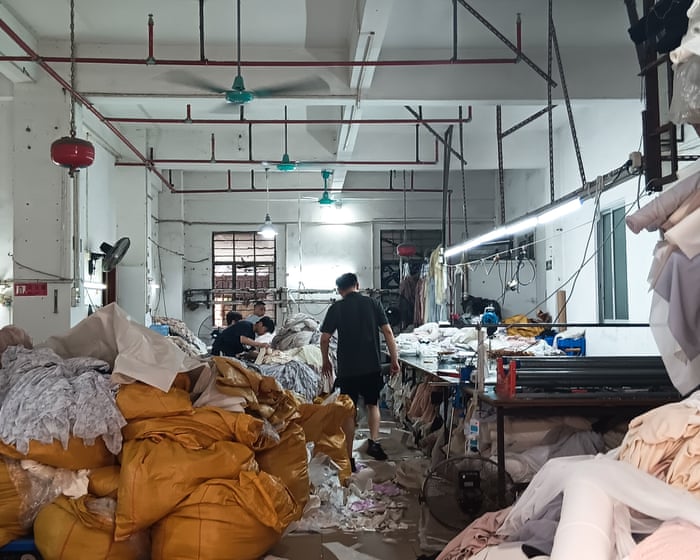Ms. Qiu stands dejected at a day labor market in Panyu, a working-class neighborhood on Guangzhou’s outskirts. She hopes to find a factory willing to hire her for the day to sew cheap tops and dresses—garments destined for Chinese e-commerce sites or export to Western shoppers. But opportunities are scarce.
“The whole industry is struggling,” she says, withholding her full name. “With the trade war driving up tariffs on Chinese goods, many foreign clients have cut their orders.”
Guangzhou, southern China’s bustling megacity and Guangdong’s provincial capital, is home to nearly 20 million people and serves as the pulsing heart of global fast fashion. In its urban villages—once-rural settlements swallowed by the city’s expansion—millions of workers labor in cramped workshops, churning out cheap clothing. In one small factory, women hunch over sewing machines beside towering stacks of stiff black tutus. In another, pink denim jeans bound for fast-fashion giant Shein cover every available surface.
Each morning, workers gather in informal job markets like Panyu’s, hoping to land a day’s work sewing buttons or ironing collars. Pay ranges from one to ten yuan per piece, depending on the task’s complexity, earned through long hours in stifling conditions.
“This is hard-earned money,” says a man in his 60s in Datang, another urban village north of Panyu. At 8 a.m., he irons jackets for export, part of a shift that began at 11 p.m. the night before. He earns two yuan per jacket. Over a dozen garment workers interviewed by The Guardian described 10- to 12-hour workdays, with some saying they take just one day off a month.
### “Little Room for Profit”
While China’s domestic e-commerce boom has flourished, overseas orders remain the lifeblood of these factories. Last year, China supplied about a quarter of the $100+ billion in textiles and apparel imported by the U.S., with Guangdong alone exporting over $7 billion.
But the U.S.-China trade war, ignited by former President Donald Trump, has rattled the industry. Tariffs on Chinese goods soared to 145%, prompting retaliatory measures from Beijing before a temporary truce in May. With an August 12 deadline looming for a deal, Guangzhou’s workers worry whether American buyers will keep coming.
In Panyu, Yang Ruiping has run his small factory—specializing in tops and employing about 20 workers—for 20 years. Exports once made up over half his orders, mostly to Shein and Amazon; now, they account for just 30%. Though the trade war pause has eased pressure slightly, Yang remains wary.
“If U.S. tariffs rise, we have to slash production costs to compensate,” he says. “There’s almost no profit left.” With wages already at rock bottom, Yang admits he’s losing money on each garment. He keeps accepting orders to stay afloat but fears the increasingly cutthroat domestic market may soon force him to shut down.Shein is everywhere in Panyu. The company, founded in China but headquartered in Singapore, transformed Guangzhou’s garment industry by letting small manufacturers like Yang sell directly to Western customers at extremely low prices. While major brands use large factories, Shein places small orders with independent manufacturers and increases production for popular designs. This flexible approach fueled Shein’s rapid growth—it now makes up about half of the U.S. fast fashion market, according to data firm Bloomberg Second Measure.
Shein’s expansion also benefited from a U.S. customs loophole that allowed tax-free imports of low-value goods. In 2022, over 30% of these small shipments came from Shein and Temu, another Chinese e-commerce platform. On May 2, Trump closed this loophole for Chinese and Hong Kong goods, later extending the ban to all countries to prevent tariff evasion through third countries. Since then, Shein’s prices have risen by an average of 23%, Reuters found.
The U.S. market is “volatile and risky,” says Peng Jianshen, who runs a denim factory in Zengcheng, another Guangzhou industrial hub. “When tariffs suddenly increased, all U.S.-focused production stopped. No one dared to continue.” Experts warn that trade war uncertainty could worsen working conditions, pushing employees to work even longer hours.
“Generally, garment workers in China don’t get rest days,” says Li Qiang of U.S.-based NGO China Labor Watch. “They’re paid per piece, so they work as much as possible while orders last.”
But Guangzhou factory owners say the trade war is just one of many challenges. Global conflicts and weak Chinese consumer spending make it hard to shift from the U.S. to other markets. Li Jun, a denim factory owner supplying Russia, says the Ukraine war and customer conscriptions have hurt business. “The economy is bad everywhere,” he says. “Many factories are closing.” His monthly exports dropped from 100,000 jeans (half to Russia) to 30,000-40,000, barely breaking even.
Guangzhou’s manufacturers once drove China’s growth, but Beijing now prioritizes high-tech sectors like AI and semiconductors. “The government no longer supports light industries or small businesses,” Li says. “It’s really hard to keep going.”
Additional research by Lillian Yang.




